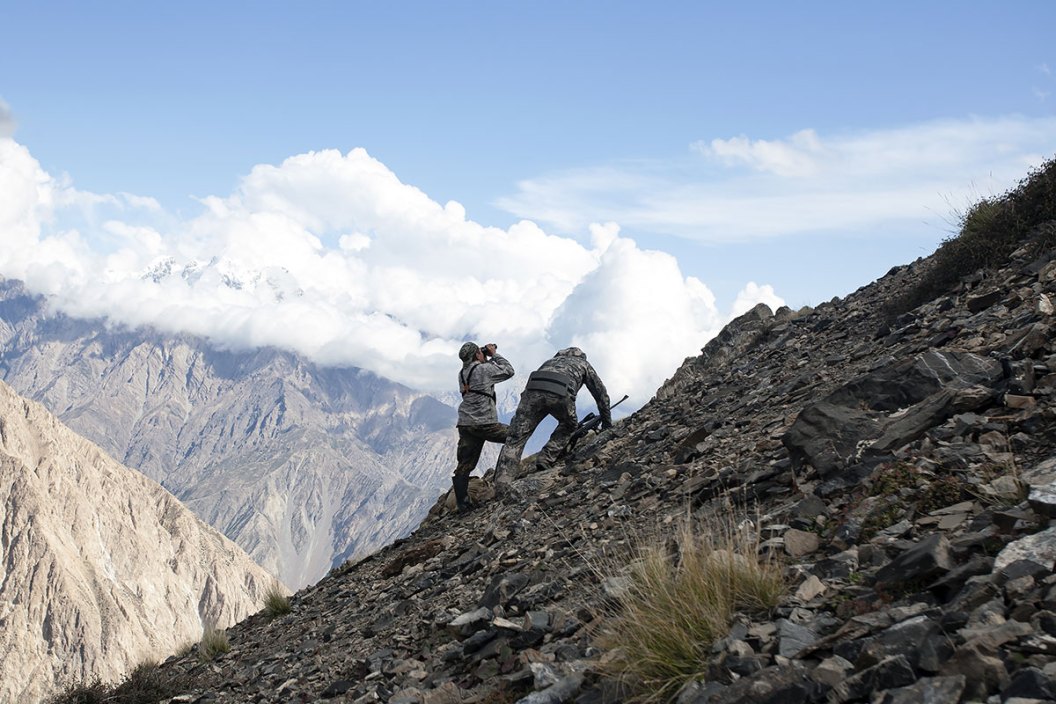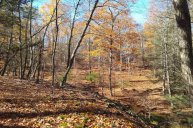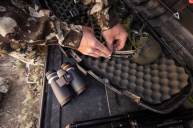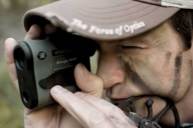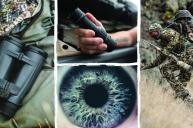There's more to spotting big game with your optics than just looking through the lens.
There's an old adage for deer hunters that when searching the cover for deer, they should try to find deer parts, not the whole deer. It's good advice.
Most veteran hunters can spot the most minute movement or the tiniest bit of an animal through the trees, and it's mostly due to the vast amount time they've spent looking for game animals.
For those who have spent their lives in search of whitetail deer, mule deer, elk, moose, pronghorn antelope, and even the revered bighorn sheep, it still comes down to knowing the animal's home and what that wild game looks like moving through it.
Maybe even more so, it's important to know what they look like at rest in their native cover.
One of the most important things about using good optics—scopes, binoculars, and even range finders—is the fact that we have to trust our eyes first. We may think we see a huge set of antlers, but more often than not we're kidding ourselves.
Even with that information, we all can agree that good quality optics were invented for a reason: our eyes still don't tell us the whole story.
First, let's take a look at the gear.
Binoculars
Binoculars are probably the most basic and obvious choice for most sportsmen and women since they are the easiest to use and the easiest to carry into the field. They go by the long name binoculars, or binos, binocs, or just glasses. There are many types of binoculars such as roof prism, Porro prism, night vision optics, and even Marine binoculars, just to name a few.
For our purposes we will stick to the basics: roof and Porro prism binos which are best used for hunting, scouting, and even bird watching. Most of what we use today are the more modern of the two, the roof prism version.
A pair of binoculars is made to be more lightweight, and can be much more streamlined than the older-style Porro prism binoculars. Roof prism binocs produce a much higher magnification power and brighter look in the lens, but those great features come with a higher price tag.
Maybe the best part about them is that they are much more compact while still having great magnification. Porro prism binocs are more affordable and have a wider field of view, making them terrific for scouting and even sporting events, but they are usually more bulky.
Binocular harnesses have become popular, keeping your glasses within arm's reach but still tucked away when not in use.
Spotting Scopes
Hunters sometimes need to verify legitimate game and shot placements with more tactical ranging and surveillance at long distances. For these and any other applications that require more magnification than a pair of typical binoculars can provide, spotting scopes are where it's at. They're typically on the order of 20-60 times more powerful than binos.
Since the higher magnification of spotting scopes makes them prone to image movement due to the vibrations, a tripod is essential. They provide a steady base on which the scope can be mounted, and therefore add some more necessary gear to carry.
Similarities and Differences
Binos and spotting scopes have their plusses and minuses. Binoculars are more mobile, can be used and stashed at a moment's notice, and less vulnerable to the effects of movement. Spotting scopes can see farther and with more detail, but typically cost more on average.
Both binoculars and spotting scopes can have enlisted range finders in their devices meaning that they can not only tell a hunter where the game is, but how far as well. On a side note, this feature makes them great for use at the shooting range as a spotter for your pals. It's a good way to stay precise and learn more about your firearms and bows.
Quick Tips for Spotting Game
Of course, any good glassing session starts with a glassing spot. In almost every case, it is always the first order of business not to expose yourself on a peak or ridgeline. Providing the animal a nice silhouette of a human staring straight at them, no matter how far away you are, is a no-no.
Locate a spot that's comfortable to sit in, out of the sun and wind if possible but preferably with the sunlight coming from behind you.
Get comfortable, but don't unpack and relax so much that you're unable to make a move at a moment's notice. You never know what you might find, and how you might want to hunt it.
If reaching a glassing spot requires a strenuous hike, give yourself time to catch your breath and settle in. You don't want to be steadying your binos through deep breaths and a pounding heart.
From there, identify the layout of the land, think about where animals might like to be, and make a note of how you might be able to get a shot off should you notice something.
Then ease your mind, calm your excitement, and start glassing for the game you will hopefully choose to pursue.
Trust Your Eyes
Maybe the first, most important tip to finding game—even at some kind of distance—is to verify what you are seeing based on your experience, specifically with animal movement.
Start with the grid pattern you've heard so often, and work your way through the are you're glassing. Look for abnormal coloration, strange shapes, and especially movement.
If nothing else, our naked eyes can see motion, even from a good distance. That gives us a great starting point. Now it is a matter of discerning that motion from the surrounding cover: Is that movement from a game animal or something else?
Even in windy conditions, the movement of an animal is unique and different from its surroundings. Trees sway in the wind and leaves rustle and fall, but all with consistency. Most of the animals that we hunt will move in a different style and speed, thereby making a completely different scene through the cover.
Once the movement is identified, use your eyes to look across the top of the scope or the binoculars to give yourself a reference point. Depending on the cover and the distance to your target, start far and range in with your optics to make a solid identification.
This approach can be also be critical to finding game animals that are at rest.
First of all, animals that are hidden in the cover and not moving are the bane of hunters everywhere, and until someone comes up with a spotting scope that can make the woods and fields transparent, we're stuck with the fact that the animal has the advantage. In all honesty, spotting them is part of the fun, and I sort of hope that it always stays that way!
You'll need to concentrate on looking in areas such as open flats, hillsides, broken vegetation, or clumps of trees. Find something not so dense that you can't see a thing. Yes, big bucks like to stay hidden in the thick of it, but it's going to be tough to find a sleeping deer in the gnarliest brush, so it's worth it to move on.
Keeping Still
As we said, stability with spotting scopes is huge. But what about binos? It's still important and there are some ways to aid in your attempt.
Most of us use two hands to hold a pair of binoculars, but how you do it can vary from person to person. Simply grabbing the optic and holding it up to your eyes is the standard for most, but it's not the only way.
If you're leaning back, your elbows can often rest on your stomach, just under your ribs, for a steady base. If you wear a ball cap, you can use your index finger to brace the binocs to the bill while steadying them with the opposite hand underneath.
When big game hunting from a treestand, the tree can help to stabilize the binoculars by resting them against the trunk or an available limb while still being able to turn and scan for movement. In some cases, even using your thumb as a brace against your lower jaw can have the effect of keeping unwanted vibration from affecting your scan of the woods.
For those on the ground, binoculars can be used with a tripod too, making them very stable and easier to use. But if you don't have a tripod mount on your binocs, laying prone and resting them on a backpack or rolled up clothing as a base can help to allay some of the wiggle involved with getting a good look, especially when using a higher magnification.
Patience is the Key
The "P" word plays such an utterly important and key role in deer hunting, or any kind of hunting for that matter, and the strategy can be included into glassing as well.
We all know it's a necessity, and I think it's hard to imagine not putting the same patience into glassing that we put into other aspects. From the early morning until the end of shooting light, we've got to stay diligent. We can all imagine how many animals we missed or never saw due to being impatient!
Your vision can and will become fatigued due to the prolonged sessions glassing sometimes calls for. When using a spotting scope, it becomes important to scan with both eyes open, or alternate from eye to eye. With binoculars, one eye can be closed to rest it, understanding you'll have some decreased field of view.
Wild game doesn't just amazingly pop out of every corner and prance around to show itself. The key is to relax and enjoy it. After all, we hunt to get away from it all, and glassing is a funny microcosm of that notion.
Glassing sessions should be about getting a closer look at the bedding areas and feeding areas of our favorite game animals from long distances, whether it is during the hunt or even pre-season scouting.
Good glassing techniques go a long way. The more you know about your hunting area, the less time wasted looking. You'll learn the backcountry spots that are devoid of game, and find out how to concentrate on ones that are obvious holding areas.
There's a lot of wide open country out there. If you're good at spotting game in it, you've got an edge as a hunter.
Looking for a little more or even hot lunch for your hunting blind? Follow my webpage, or on Facebook and Twitter.
NEXT: SMALL HUNTING PROPERTY? HERE ARE 6 IMPROVEMENTS THAT WILL MAKE A BIG DIFFERENCE
WATCH
